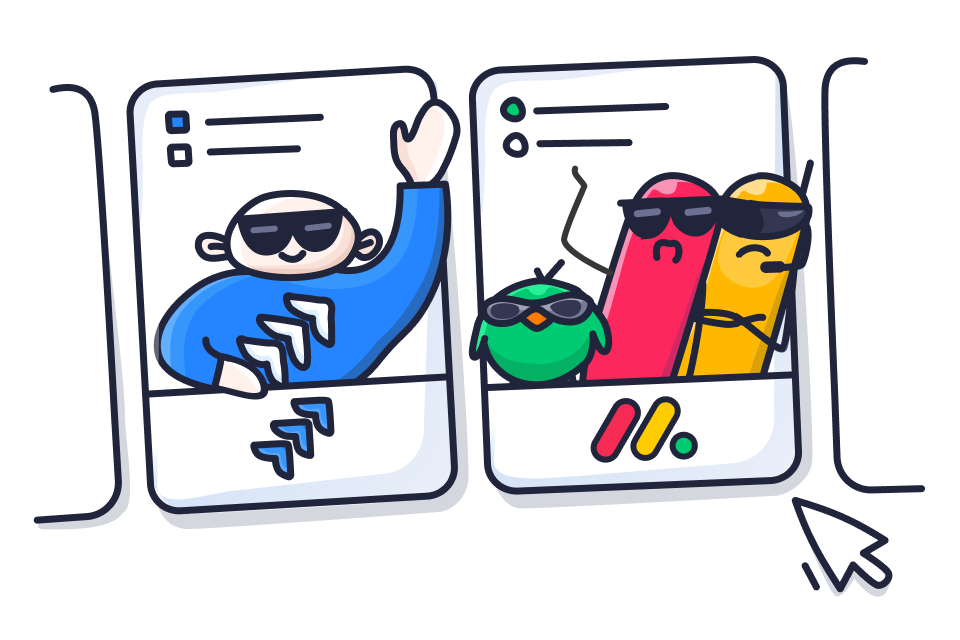Jira has been around for so long that it feels like it’s always been part of the software development world. It’s appreciated for its versatility, deep alignment with agile practices, and ease of integration with other tools. In contrast, Monday is a much newer platform, recognized for its modern look, customization, and intuitive UI. It offers impressive functionality paired with fast onboarding.
In this article, we compare the two platforms and explore their pros and cons. We start with a general overview and then take a closer look at the agile-related features of Jira vs. Monday. This will help you choose the right solution for your goals.
Jira Overview: Pros and Cons
Jira is a project management platform created in 2002 that is now used by over 300K companies. Initially built as a bug tracking tool, it later evolved into a full-fledged Agile solution for running complex projects. Today, it can be adapted to different frameworks, including Waterfall and various mixed models.
Jira is flexible and can support teams ranging from 2 to 2000 and more people in size. For smaller ones, it offers a team-managed project type with adjusted functionality and pricing. Larger teams can work with a company-managed project type, which has more advanced functionality. Both types provide a variety of agile features. They include Scrum and Kanban boards, sprint management capabilities, and tailored reporting. All this allows teams to effectively run sprints in Jira, track bugs, and organize work on various tasks.
While software development teams widely use Jira, it can also be adopted in other contexts. Its Scrum project template is suitable for any agile team that prefers working in sprints.
Jira pros:
- A robust platform with extensive functionality
- Versatile and suitable for a wide range of processes
- Tailored for agile product development
- Can be used by teams working in different areas
- Offers advanced filtering and search with JQL (Jira Query Language)
- Features robust built-in Automation for Jira
- Includes native support for Confluence and Loom
- Has deep integration with Open DevOps
- Supports over 3,000 apps and integrations from the Atlassian Marketplace
- Includes different views, such as list, board, and timeline views
- Allows creating custom work types
- Highly customizable and feature-rich
Jira cons:
- Requires a steep learning curve
- The interface can feel overly complex for beginners
- Less suited for non-technical teams in terms of user experience
- Uses terminology that can feel obscure and takes some getting used to
- Performance can sometimes be slow when running complex queries
From this overview, you can see that Jira offers extensive functionality and flexibility. At the same time, it can require some learning to set up and adjust for your team’s needs. However, if you use agile methodologies and have a good understanding of what your processes should look like, Jira is an excellent choice.
Here’s a quick summary of the pros and cons in the form of an infographic. Save it in case you need to review this information later.
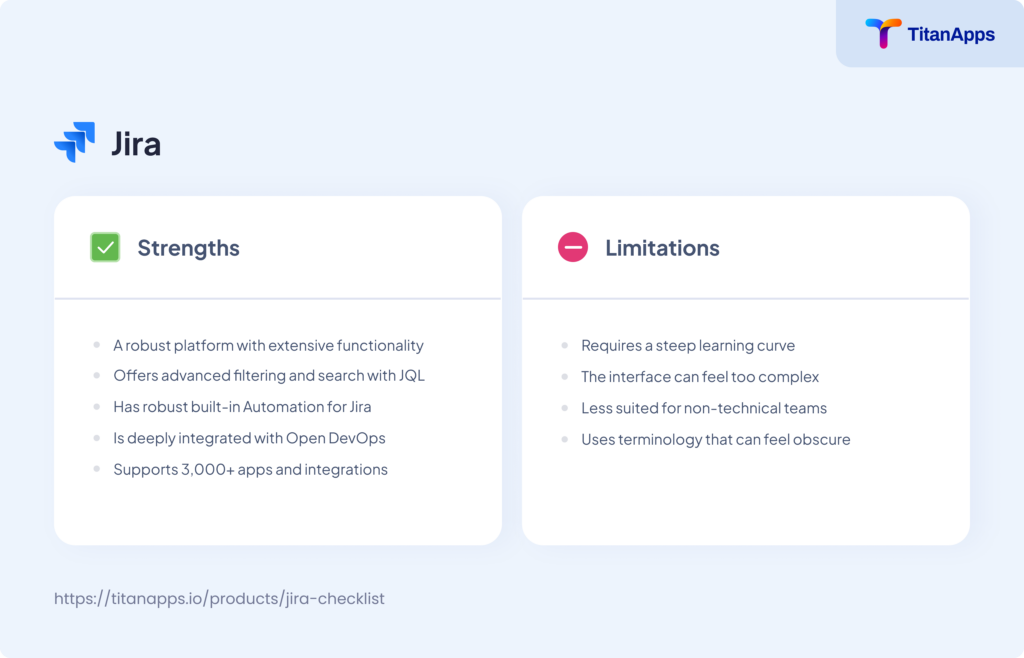
Monday Overview: Pros and Cons
Monday is a project management solution that was launched in 2014, currently serving over 245K customers. It’s marketed as “Work OS” – an all-in-one platform for managing workflows. Work OS includes several separate products: a “work management” platform, a service management tool, a CRM, and the Monday Dev platform. In this article, we compare Jira vs. Monday Dev, as it’s the only agile product under the Monday umbrella.
As the name suggests, Monday Dev is designed for software development teams. It provides the necessary functionality to work with Scrum, Kanban, Waterfall, and hybrid frameworks. The platform offers customizable boards, sprint management features, templates for running retro meetings, and more. It also provides integrations with popular dev tools, such as GitHub and GitLab. In addition, it has dedicated features for bug tracking and building roadmaps.
If needed, teams outside of software development can also utilize Monday dev and organize work in sprints. If sprints are not necessary, then, for non-tech teams, it’s better to opt for Monday Work Management. Other Monday products (except for Monday dev) offer a Kanban board, but they are not optimized for time-boxed iterations overall.
Monday pros:
- A strong and modern solution for project management
- Easy to use out of the box, offers fast onboarding
- User-friendly interface, well-though-out user experience
- An appealing design with vibrant colors
- Drag?and?drop workflow setup
- Native trigger-based automations
- A variety of views, including Gantt charts and a table, timeline, and calendar views
- Customizable widget-based dashboards
- High adoption rates across teams due to the ease of use
- Supports 200+ apps and integrations from the marketplace
- Provides whiteboards for collaboration
- Offers highly rated customer service
Monday cons:
- No free plan for Monday Dev, regardless of the team size
- Very limited agile functionality in the Basic plan
- Cloud-only product, can’t be run on your own infrastructure
- Fewer apps and integrations available compared to Jira
To sum up, Monday is a user-friendly solution that allows you to manage agile projects and easily visualize all workflow-related information. Thanks to its intuitiveness, you can get started quickly and effortlessly. However, for maximum effect, it makes sense to dive deeper into the settings. You will need to map your processes to the platform, set up custom workflows, and add the required integrations.
Here’s a brief summary of the pros and cons we discussed above.
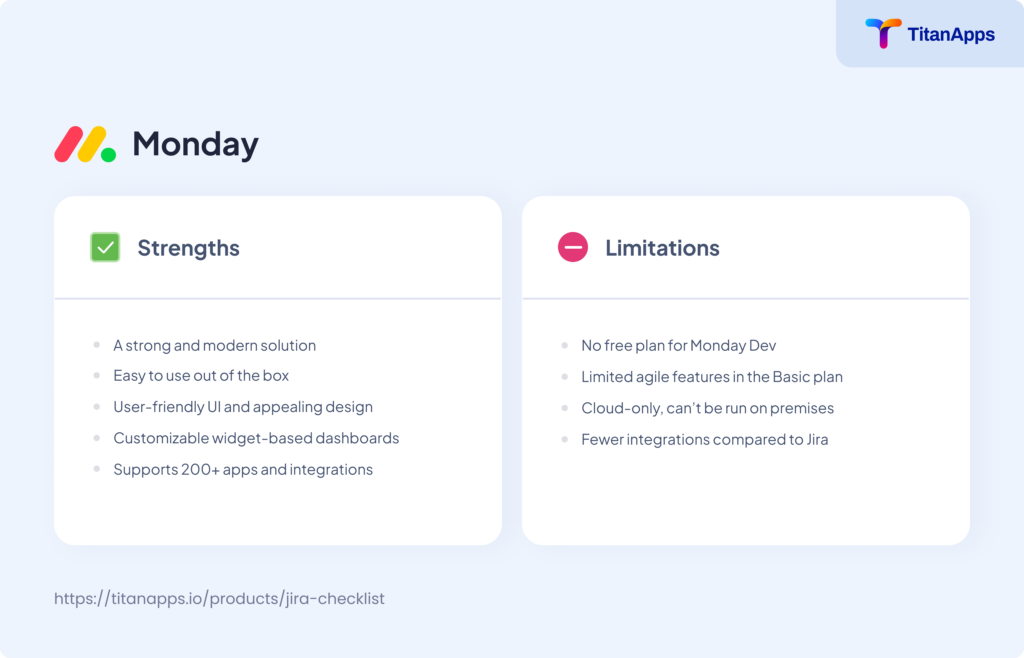
Agile Features in Jira vs. Monday: What do Both Platforms Offer?
An agile team needs tools that will allow it to organize work in sprints, track project progress, and iterate based on feedback. Let’s see how Jira and Monday back up agile processes and help teams work efficiently.
Agile Templates
Both platforms offer various templates that help you set up your project faster. They include the essential building blocks and serve as a solid basis for further customization.
Jira templates for Agile project management:
- Scrum project template – This one is the most relevant for agile teams as it’s attuned to organizing and managing work in sprints. It contains pre-configured work types, custom fields, workflows, and more. The sprint management features include sprint planning and a Scrum board. There are also built-in agile reports, such as a Burndown chart and Sprint report.
- Kanban project template – Unlike the previous one, it’s not optimized for time-boxed delivery. The distinguishing feature of this Jira template is a Kanban board, which is designed for continuously pulling work. It also contains pre-configured work types, customizable workflows, and reports, but doesn’t offer functionality for managing sprints.
Please note that the Kanban approach is sometimes not considered agile because it focuses on the continuous flow of tasks, not on time-boxed iterations. However, Kanban is often part of mixed methodologies and custom agile frameworks.
- Other templates useful for Agile teams include Agile roadmap template and Agile project plan template. These mostly offer you the same features, as you will still need to base them on a Project Management, Scrum, or Kanban project template.
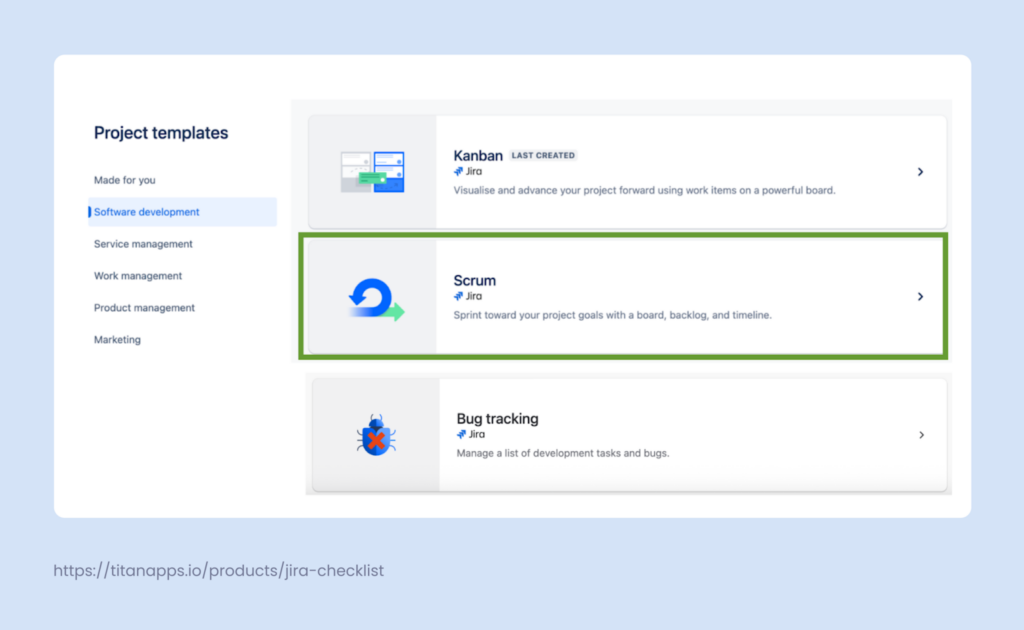
Monday also offers several templates for agile teams:
- Agile Project Management template – This template allows you to set up a project roadmap with goals by quarter, track tasks on a Kanban board, and plan sprints in a dedicated view. Additionally, it includes widgets to track the individual workload of team members.
- Scrum Team template – A dedicated Scrum pack that includes an agile board, Sprints tab, Task and Epic views, Bugs Queue for bug tracking and management, and a Sprint Retrospective template.
- Kanban software development template – tThis template includes a Backlog, Committed plan, a Kanban board with a work-in-progress limit, and a Kanban dashboard showing the key metrics. Please note that this template is not optimized for working with sprints.
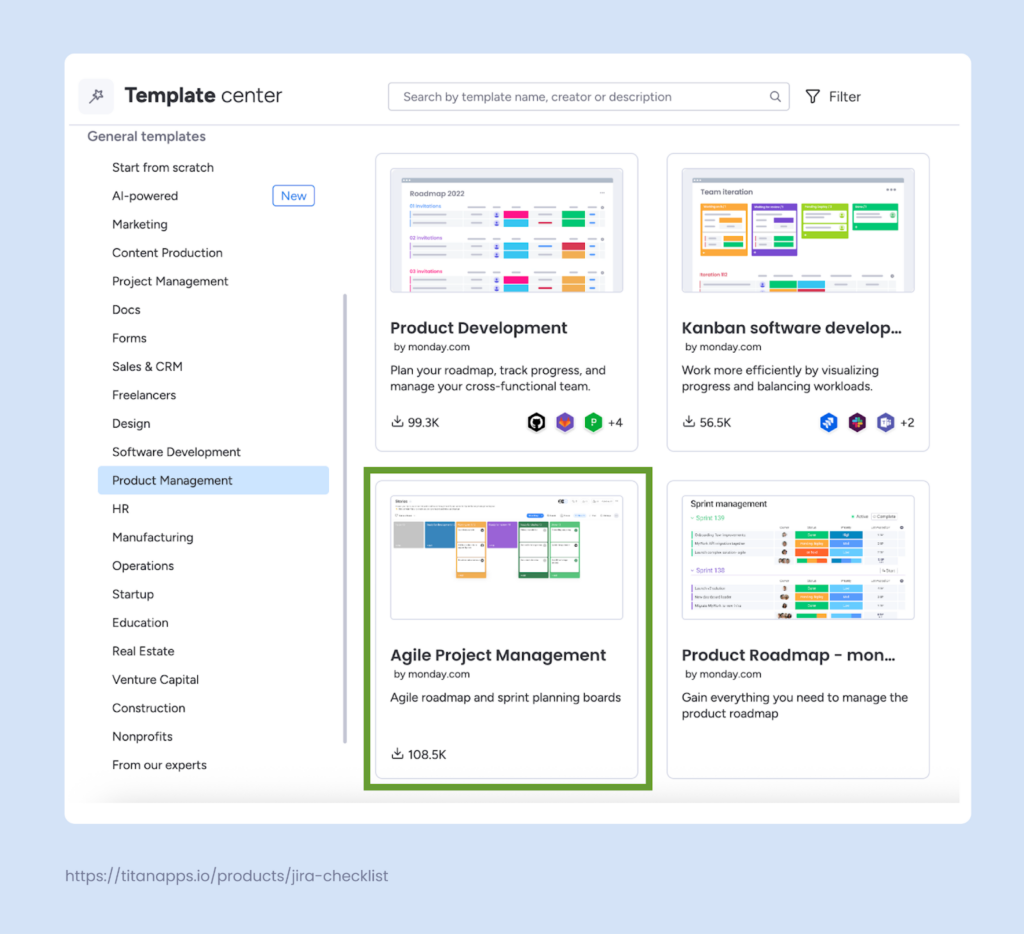
The structure of the templates on both platforms is more or less similar. To estimate which one suits you better, it’s best to try them first-hand and see which features will be useful for your team.
Agile Board
Jira offers you two types of boards, each tailored to a different framework: a Scrum board and a Kanban board. The Scrum board only shows tickets related to the current sprint, allowing your team to focus on tasks at hand. In contrast, the Kanban board is designed for a continuous pull. It will enable your team members to take new tickets from the backlog once they have completed their previous tasks.
Another feature of the Kanban board is a WIP limit (work-in-progress limit). You can set the maximum allowed number of tasks that have the “In progress” status. This prevents your team from losing focus and overcommitting.
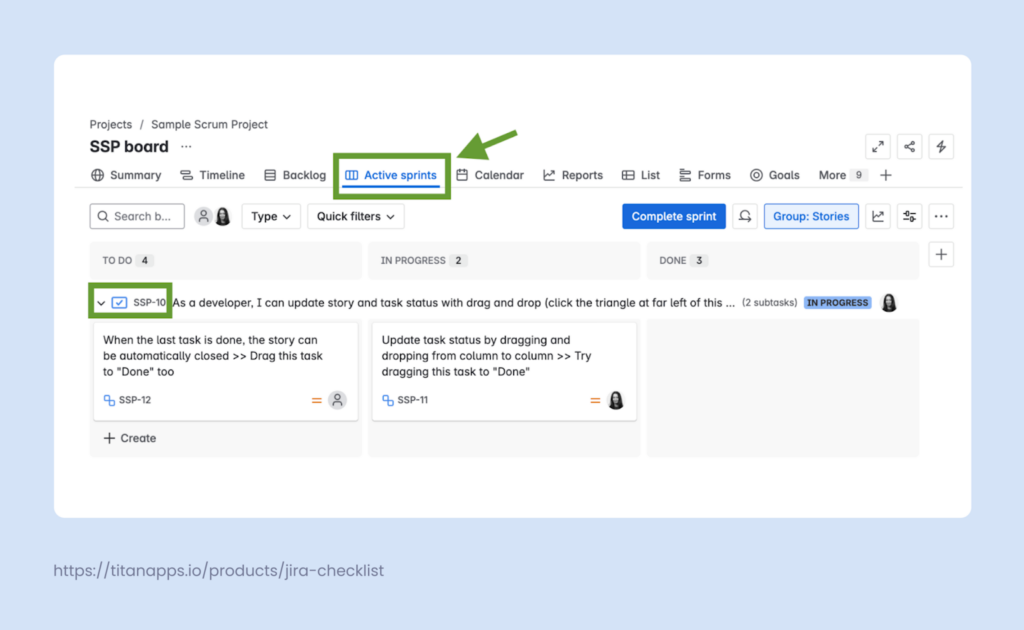
With Monday Dev, things are slightly different. Technically, you only have a Kanban board, but de facto, it can function as a Scrum board. If you have an active sprint, by default, the board will show tickets from that sprint only. To change this, select other filters. For example, you can add more sprints or choose to display all sprints. Additionally, you can set WIP limits.
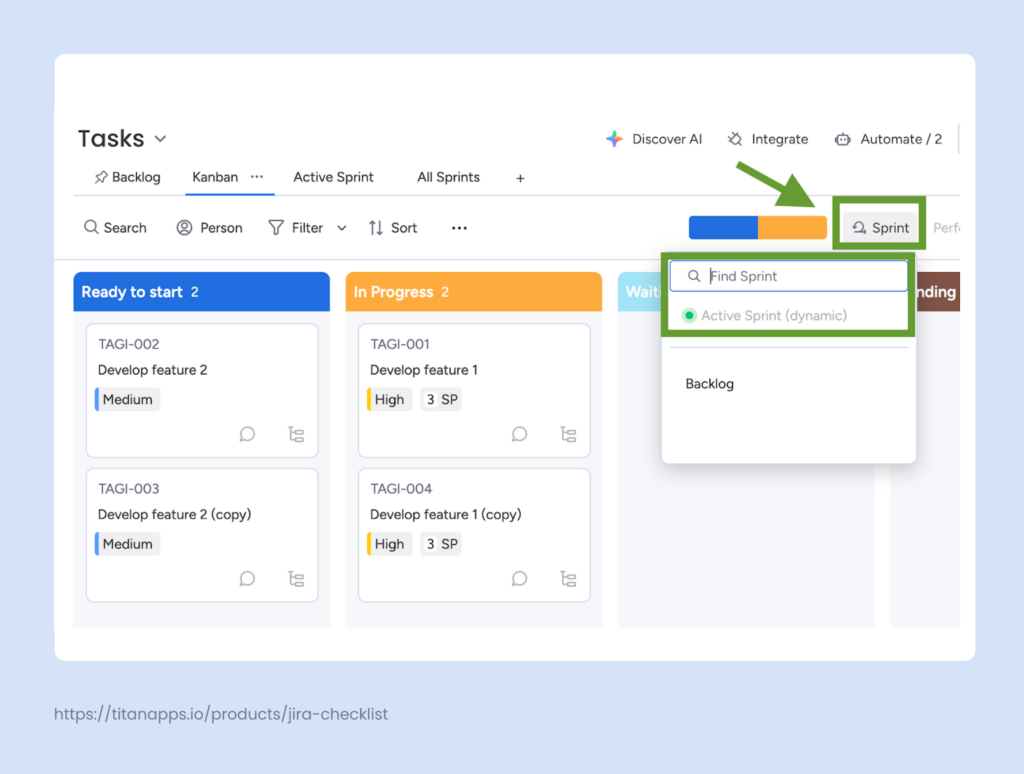
Both platforms allow you to configure your boards by deciding which columns to include and how to link them to your workflows.
Sprint Planning
In Jira, you can plan the next sprints from the Backlog of your Scrum project. The drag-and-drop interface makes it easy to move work items from the product Backlog to the sprint scope.
From this view, you can also change priorities, rearrange work items, view the estimated number of story points, and access other related information. Sprint planning is available out of the box for projects created with the help of the Scrum template.
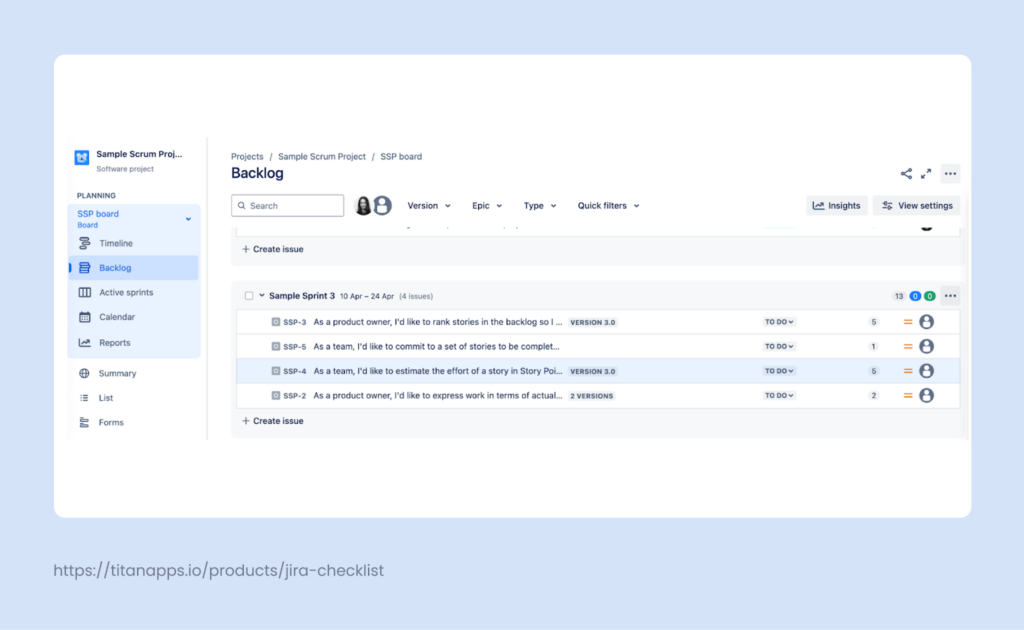
In Monday Dev, this feature works in a similar way. If you use an Agile Project Management template, you will have a dedicated Sprint Planning tab. There, you can view your planned sprints, estimated story points, and track progress. To change the scope or plan a new sprint, drag the tickets from the backlog or create new ones.
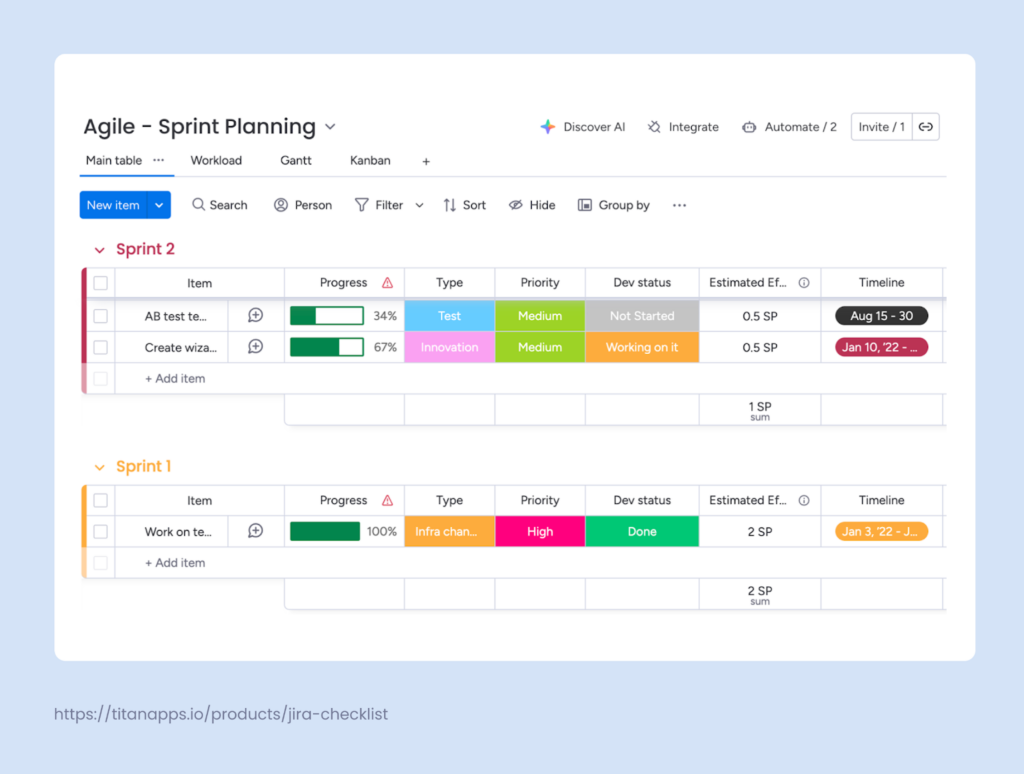
If you use a different Monday template, you will have the Sprints tab with roughly the same functionality. You can use multiple templates in your workspace. Additionally, Monday Dev allows you to choose which columns to include in your sprint planning table. The customization options include tags, votes, ratings, drop-downs, and various AI actions, such as summarizing.
In general, when comparing Jira vs. Monday, it’s clear that Monday provides more customization options in terms of presenting and visualizing information.
Apart from sprint planning, both platforms enable you to plan and manage releases.
In Jira, releases (also called fix versions) are one of the core features with rich functionality. This includes version progress tracking, linked work items added to the version, and built-in release notes and reporting. As a result, you can view, manage, and analyze all work within a release from one place. As releases are separate entities (much like sprints), you can use them with automation. For example, assign work items to a fix version automatically.
In comparison, Monday Dev doesn’t natively offer releases/versions as a separate entity. As a workaround, teams can try to simulate releases by grouping tasks or configuring table columns in a particular way. However, this means you will have fewer automation and reporting options compared to Jira.
Story Points Estimation
Assessing the time required for a task is crucial for effective sprint planning. Jira and Monday both allow you to add estimates in a dedicated field of a work item. By default, it’s story points, but it’s possible to configure fields for other estimation approaches, if necessary.
Here’s what story point estimation looks like in Jira:
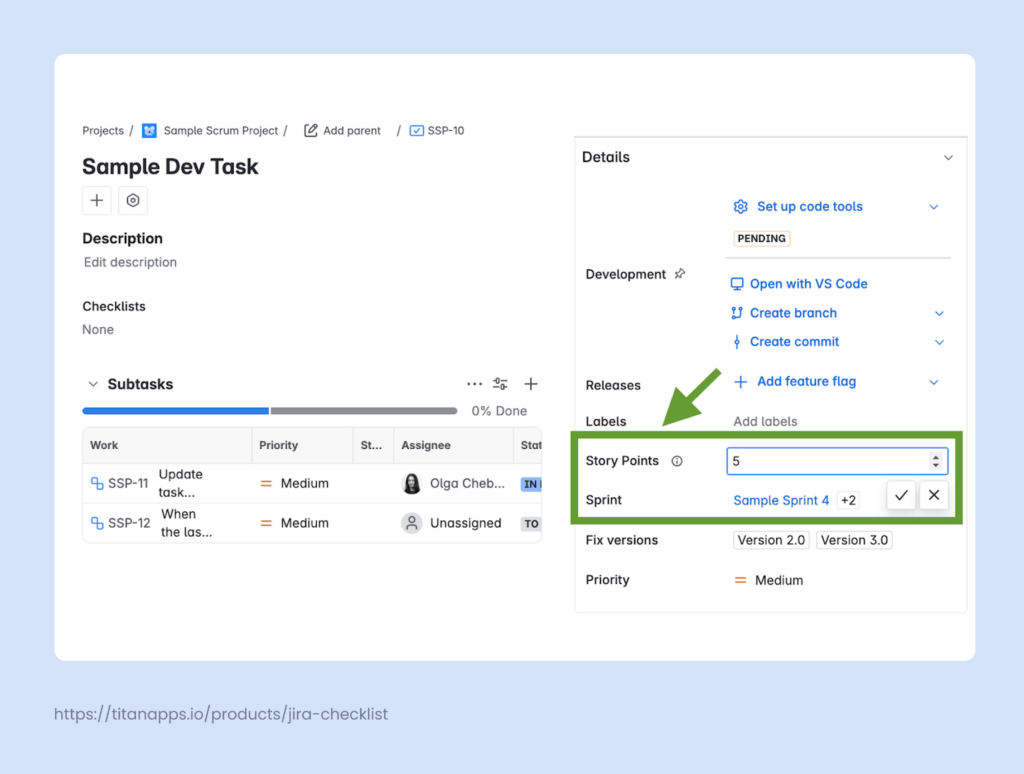
And this is the Monday Dev example:

As you can see, there’s an additional field included out of the box, Actual SP. It allows you to analyse how correct your estimations were once the task is completed.
This feature is similar in both platforms. It allows you to record your estimations and use them in planning. If you want some extra functionality, such as planning poker, you can use a dedicated add-on for your project management tool.
Agile Reporting
In Jira, you will find almost two dozen different reports. For an agile team, the most essential ones are Burndown and Burnup charts, a Sprint report, and a Velocity report. They allow you to analyze your progress, plans, and results from various angles.
For example, the Burndown chart helps you estimate current progress and see how much work still needs to be completed. This enables you to project whether the team is likely to achieve the sprint goals at the current pace. The Velocity report shows you how your team performed from sprint to sprint. This data is valuable for building projections and planning a future scope. In general, these reports help you manage sprints effectively and provide a good overview of the achieved results.
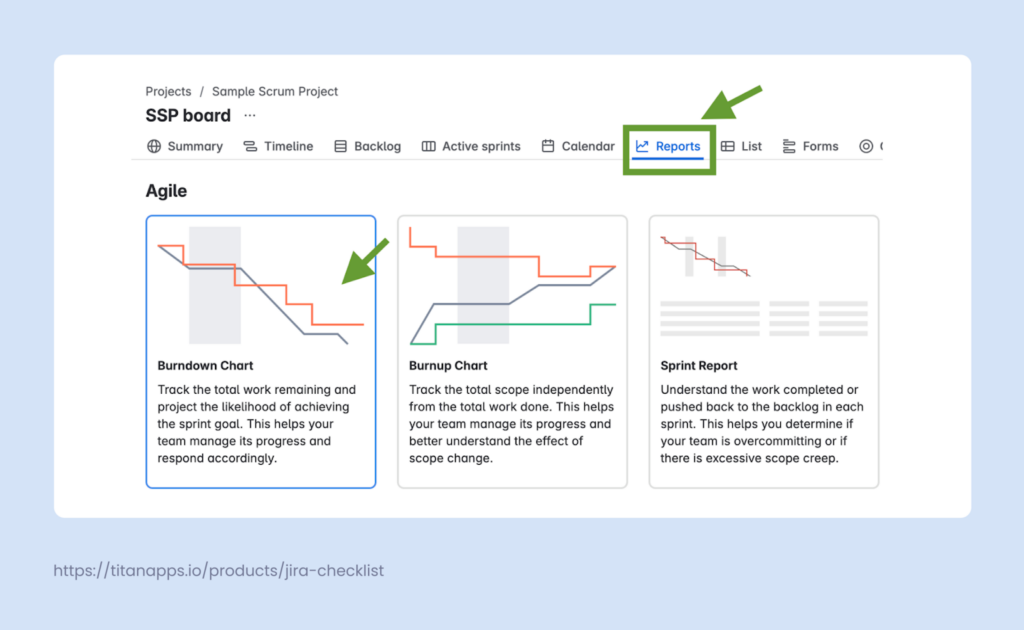
Monday Dev offers a similar set of reports, including the Burndown chart, Velocity report, and Sprint report. In addition, the system generates an AI summary for the closed sprint. It contains a sprint description, analysis of the task completion, and suggested action points. These takeaways can be useful for retrospective meetings and communicating the results to stakeholders.
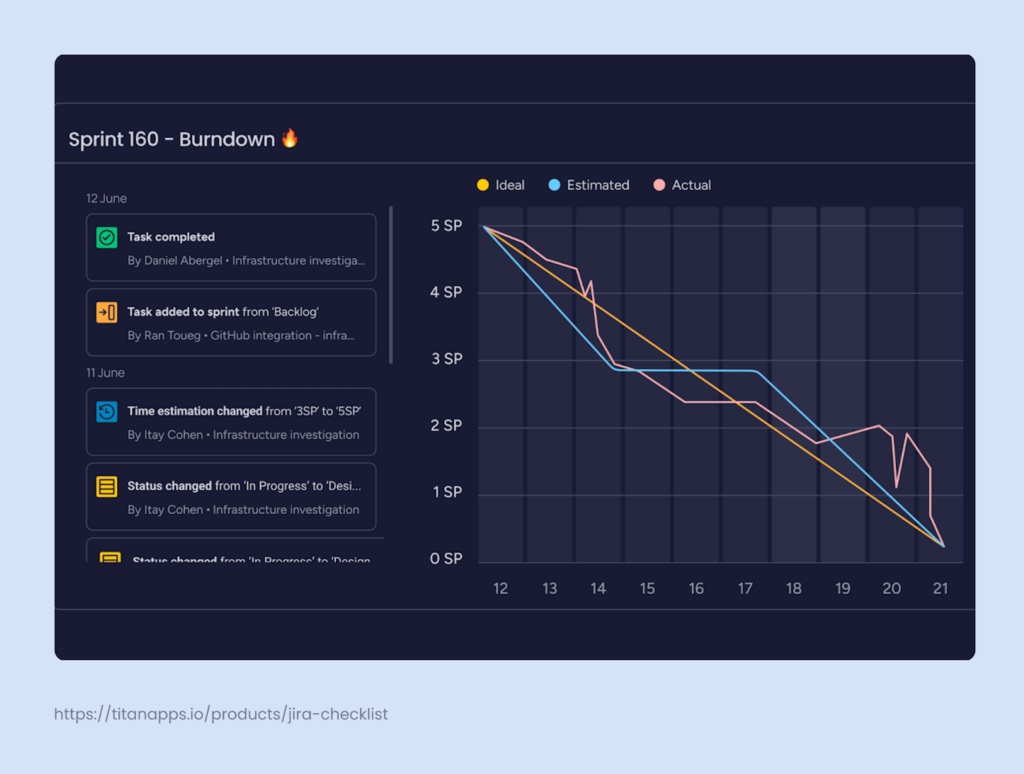
Another reporting tool available in Monday Dev is a customizable dashboard. Its drag-and-drop functionality allows you to quickly add various widgets with graphs and KPIs that matter most to your team.
Integrations
By connecting your project management platform to other tools, you can significantly expand its capabilities. Monday’s marketplace offers over 200 add-ons, while Jira integrates with over 3000 apps and connectors.
These integrations cater to a wide range of use cases. For example, you can connect to development tools and sync information on commits and pull request statuses. A common use case is connecting Jira or Monday to Slack. This allows you to set up real-time notifications and create tickets directly from Slack conversations. All this helps you streamline task management and reduce context switching.
Another example is integrating with a checklist app to implement agile checklist templates. In the screenshot below, you can see a Definition of Done template created with the help of Smart Checklist by Titan Apps.

## Definition of Done
- **Code complete.** All code has been written and reviewed, and all necessary functionality has been implemented.
- **Code coverage.** All code has been tested and meets the required code coverage threshold.
- **Code quality.** Code has been written using the required standards, conventions, and best practices.
- **Integration.** Code has been integrated into the main branch, and all integration issues have been resolved.
- **Security:** The software has been tested for security vulnerabilities, and all issues have been resolved.
- **Performance:** The software has been tested for performance and scalability, and all issues have been resolved.
- **Peer review.** The code is reviewed by the peers.
- **System testing.** The software has been tested end-to-end, and all system tests have passed.
- **Regression testing.** All previously implemented functionality has been tested, and regression tests have been passed.
- **Documentation.** All necessary documentation has been written, reviewed, and approved, including user manuals, API documentation, and system documentation.
- **Acceptance testing.** The functionality has been demonstrated to the product owner or customer and has been approved.
- **Deployment:** The software has been successfully deployed to the production environment, and all deployment issues have been resolved.
This solution enables you to create feature-rich checklists, save them as templates, and automatically apply them to your tasks. Smart Checklist is available for Jira and Monday. You can also use other Templates for Agile Teams.
While Jira offers significantly more integrations than Monday, it makes sense to assess your needs before making a choice. Start by listing the main apps you want to connect with and check their availability on each platform’s marketplace.
The Key Differences Between Jira vs. Monday – A Comparison Table
| Feature | Jira | Monday |
|---|---|---|
| Versions | – Cloud and on-premises versions available: Jira Cloud and Jira Data Center | Cloud-only, no on-premises version |
| Clients | Over 300K companies | Over 245K customers |
| Integrations | 3,000+ apps and integrations | 200+ apps and integrations |
| Ease of use | Has a steep learning curve | Has a user-friendly and intuitive interface |
| Agile features | – Sprint management – Story point estimation – Scrum board – Kanban board | – Sprint management – Story point estimation – Kanban board |
| Reporting | – Burn-up chart – Burndown chart – Sprint report – Velocity chart | – Custom dashboard – AI analytics – Burn-up/ Burndown charts – Performance insights |
| Other features | – Advanced filtering and search with JQL – Custom work types – Advanced customization | – An appealing and modern design – Drag-and-drop dashboards – Native whiteboards (workdoks) |
Jira vs. Monday: Pricing Comparison
The differences in pricing plans warrants a separate mention. With many features more or less similar, the financial factor plays an important role in choosing the best platform for your organization.
For small teams, Jira can be a more cost-effective solution as it’s free for up to 10 users while offering a rich set of features. In contrast, Monday Dev doesn’t have a free option, regardless of team size.
The cost of the cheapest paid plan is almost the same for both platforms. However, users sometimes complain that Monday’s Basic plan offers little value, as many crucial features (such as agile reporting and integrations) are unavailable there. At the same time, Jira allows you to use these features even in the free plan.
On the other hand, Monday Dev’s Basic plan includes 500 AI credits/month. This allows you to write with AI, improve text, translate, and prioritize with AI. In contrast, Jira offers AI features only to Jira Premium users.
Here’s a detailed breakdown of the Jira vs. Monday pricing:
| Jira | Monday | |
|---|---|---|
| Free plan | – Free for up to 10 users, with unlimited projects and unlimited views – Includes access to Scrum, Kanban, and all other project types – Includes agile reporting and integrations | – No free plan for Monday Dev, which is the only product optimized to work with Scrum – Monday Work Management is free for teams of 2 users, for up to 3 boards (includes a Kanban board) |
| Basic and Standard plan | – $8.60 per user/month for the Standard plan. – Includes user permission management, external collaboration, multi-region data residency, and 1700 automation rule runs per month | – €9 per user/month for the Basic plan. Includes sprint management, sprint reports, and 500 AI credits/month – €12 per user/month for the Standard plan. Includes agile reporting, integrations, and single roadmap planning |
| Premium plan | – $17 per user/month for Jira Premium for 11-100 users – Price is lower for over 100 users, adjusted depending on team size. The exact figures are available on the website. – Includes AI features, cross-team planning, managing approvals, and other advanced features Pricing details | – €19 per user/month for Monday.com Pro – Lower prices might be available for teams of over 50 users. Details can be requested from Sales – Includes Agile reporting, Cross-team Roadmap, and Actual vs. Planned tracking Pricing details |
Both platforms offer free trials for their paid plans. Please note that in Monday Dev, you can lose access to the created tasks and boards once the trial ends (until you upgrade).
Factors to Consider When Choosing Between Jira vs Monday for Project Management
Before making a decision, analyze your team’s needs and then determine which tool best meets them. Here are some of the questions that can help you:
- What is the size of the team that will be using the project management platform?
- Do your team members have previous experience with Jira software or Monday OS? If yes, what is their feedback?
- What are the main use cases and project types you will need?
- Which tools do you want to set up integrations with?
- Do you need to use built-in AI features actively?
- Does your project require on-premises hosting for security reasons?
Once you have a clear picture of your team’s requirements, compare them to what each platform offers. You can use our Jira vs. Monday comparison tables and infographics with pros and cons. They will provide you with a quick overview of the main differences and value offered by each platform.
Summary: So, Who Wins the Monday vs. Jira Battle?
The answer to this question depends on your priorities. Undoubtedly, Monday Dev has a more vibrant user interface and gives you more choices in how to visualize or present your data. You can pick colors, select what columns to include in a view, drag and drop widgets for your custom dashboards, and more.
Thanks to the platform’s intuitiveness, it’s relatively easy to onboard team members even if they don’t have a technical background. At the same time, configuring a project that is tailored to your processes will still require diving deeper into detail and investing some time in the setup.
Jira, on the other hand, offers you more connectors and add-ons, robust automation capabilities, and deep integration with Open DevOps and other Atlassian products. All this makes it a good choice for complex projects and coordinating cross-team collaboration.
Another advantage of using Jira is cost optimization. The price of its Standard and Premium plans is lower than what Monday Dev charges you for its Basic and Premium plans. Moreover, Jira has a feature-rich free plan for smaller teams.
Despite all this, it doesn’t necessarily have to be a Jira vs. Monday situation. Some agile teams adopt both platforms. For example, Jira for the development team and Monday for the design, marketing, or sales team. This can be a feasible option, especially if you already use other Atlassian and Monday products, such as Bitbucket, Monday CRM, Trello, or other collaboration tools.
We hope this in-depth tutorial helps you choose project management software that is right for you. Thank you for reading!
